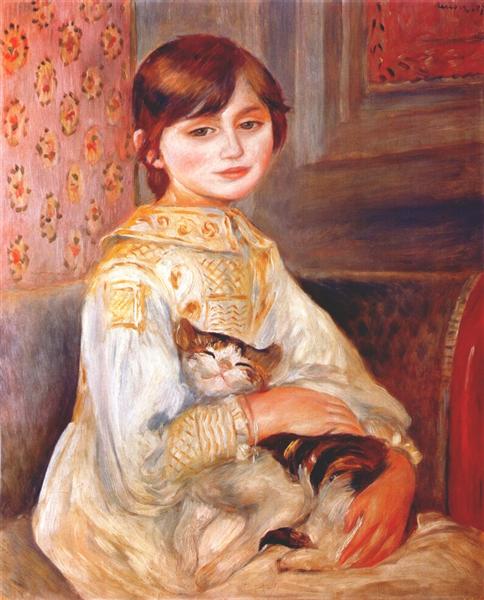תיאור
The painting "Boy with Cat (Julie Manet)", created in 1887 by Pierre-Auguste Renoir, is a work that resonates with the intimacy of an everyday scene in a corner of the French bourgeois world of the late 19th century. In this work, Renoir captures the essence of childhood through the depiction of Julie Manet, the daughter of his friend and colleague, the art critic Félix Nadar. Julie, portrayed serenely, holds a black cat with white spots on her lap, an act that evokes both the tenderness and vulnerability of childhood.
From a compositional perspective, the painting is notable for its closeness between the viewer and the scene depicted. Julie's figure occupies the foreground, where her gaze and expression become the focus of the piece. Renoir employs a technique of loose, fluid brushstrokes, which not only brings dynamism to the work, but also infuses a sense of liveliness and realism to the girl's features and the cat's texture. The lighting is subtle and warm, a characteristic element of Renoir's style; the light seems to come from a natural source, reflecting the serene atmosphere of the moment captured.
The use of color in Boy with Cat is particularly notable. Renoir selects a soft and harmonious palette, with warm tones predominating with shades of yellow and orange suggesting warmth and familiarity. Julie's costume, which features a beautiful blue dress, contrasts delicately with the cat's black fur, creating a visual dialogue that draws the viewer's attention to the central figure. This simplicity and effectiveness in the use of color are a testament to Renoir's Impressionist style, which is noted for its ability to capture light and movement in his works.
The intimacy of the scene is heightened by the relationship between the boy and the cat, which can be interpreted as a metaphor for the connection and love that often characterises childhood. This symbolic bond echoes other portraits of children in Renoir's work, where the innocence and joy of being young are manifested through the depiction of daily activities and family relationships.
Although simple in appearance, Boy with Cat also serves as an example of Renoir's evolution as an artist in the 1880s. At this stage in his career, the painter began to explore in greater depth the depiction of human figures in their everyday surroundings, moving away from the group painting that had been common in his earlier works. By focusing his attention on the singular figure of Julie, Renoir establishes a milestone in his own work, as he finds himself at an intersection between the human figure and the environment, which would later allow him to approach the figure in even more complex contexts.
When looking at “Boy and Cat,” the viewer not only witnesses a fragile moment of childhood, but can also sense the presence of the bourgeois world that Renoir so skillfully portrayed. The work embodies a time when family life and human ties were deeply valued in a society in transformation. Thus, this painting endures not just as a simple depiction of a boy and a cat, but as a timeless reference to the love, fragility, and beauty of the small things that make up life. At its core, Renoir’s work always invites reflection on the richness of human experiences, encapsulated in moments that, although ephemeral, can be eternal in art.
KUADROS ©, a famous painting on your wall.
Hand-made oil painting reproductions, with the quality of professional artists and the distinctive seal of KUADROS ©.
Painting reproduction service with satisfaction guarantee. If you are not completely satisfied with the replica of your painting, we will refund 100% of your money.

